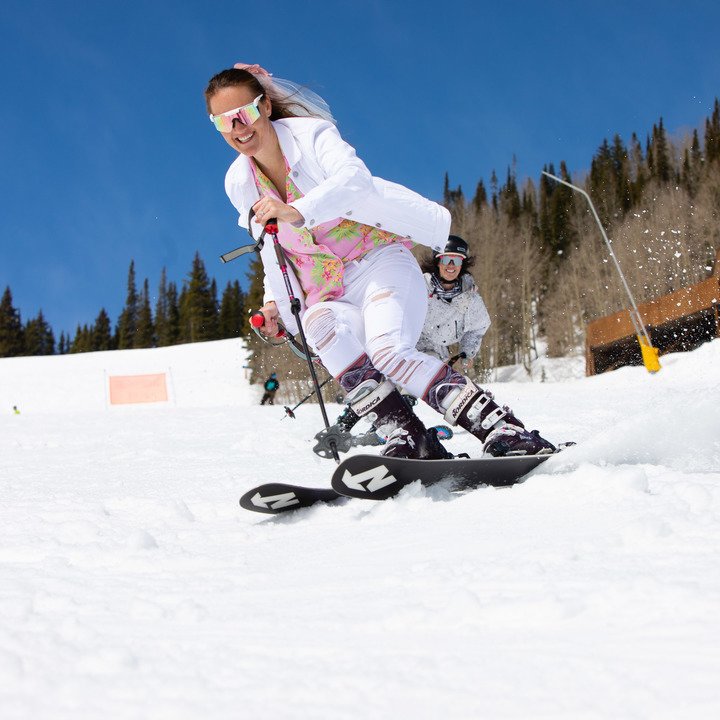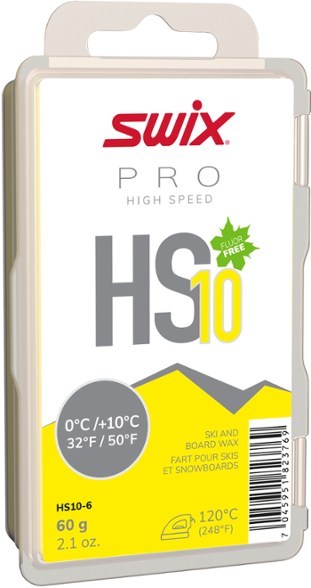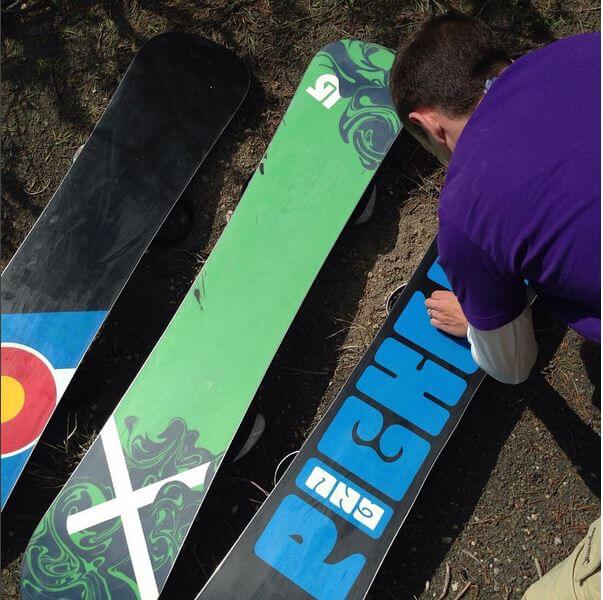Spring… the sun is shining, and it’s t-shirt weather. Turn after turn comes smoothly and then all of a sudden there is a “pull” like gremlins just came out of the sticky snow and tried to tackle you. Bummer. The day is shot, right? Well, it doesn’t have to be. A lot of times this only means your gear isn’t setup properly for the conditions. There are many ways to prevent or reduce that suction-feeling in spring snow. All kinds of different methods and strategies are used to ensure optimum performance. Here’s what we found works for us and combats sticky snow.
Sticky Spring Snow Doesn’t Have To Equal Slow

To understand what causes you to slow down, you need to understand the mechanics of what’s happening under your feet. Short and sweet, it’s known as “Wet Friction.” It’s a fancy term that means there’s high moisture content in the snow à la sticky snow. Threads of water called capillaries attach to the base and slow you down. Imagine two pieces of glass that are wet and press them together. This will create suction, and the two pieces of glass stick together like glue! Like most things in life, it’s all about balance. When water is present in small amounts, it acts like lubricant to the hard snow crystals. Once there is enough water though, it suddenly begins to slow you down.
Combating Wet Snow
Wax With Fluoro…
The easiest thing to do is understand what kind of wax works best in the snow conditions you are attempting to ride. In spring, your choice of wax is more critical than any other time of the ski season. Wax works because it reduces friction. In spring, you want to make your base waterproof so that the capillaries don’t slow you down. One of the only ways to do that was to find a wax with a high amount of fluorocarbons.
It Ain’t Cheap

Like manual transmissions in the United States, finding high quality fluorinated waxes are becoming more and more difficult. And they aren’t cheap if you do find it.
Why?!?
There’s been a lot of rumors and speculation that fluorocarbons from ski wax are harmful. Well, it’s not a simple yes or no answer but rather it depends on the manufacturer. If you’re wondering what the deal is, here’s a great article in Ski-Racing Premium providing an in-depth write-up of the controversy. Regardless, due to ski competitions making it illegal to use Fluoro waxes, companies like Swix have created new waxes that are more environmentally friendly for warm weather competitions.
Environmentally Friendly Options

Sadly, they’re just as expensive as the the Fluoro ones. I’m guessing this is because of the amount of research and design required to concoct a formula that would work as well. Swix has invested so heavily in it they have TWO waxes available. The UR10 Yellow Bio Racing Wax and the PS10. There are a few others on the market such as the Purl Yellow and Northspeed Brick Warm Wax. We haven’t used any of them yet, but the Swix one seems the most legit out of them.
What To Do If You Start Sticking
Even with the best waxing, there’s a chance you’ll start to stick especially if you’re pushing how long you’re out there. When this happens, we usually carry the following in our pocket during a warm spring session:
- Tiny bottle of citrus base cleaner (use as last resort to clean off visible dirt before applying wax)
- Paper towel to wipe it off
- Some warm weather specific paste wax (I like Maxiglide Maxx Waxx since it comes with an applicator); and if you’re environmentally conscious, there’s a new company called MountainFlow that’s putting out a product which we haven’t tried just yet
When applying wax on the slopes, remember less is more… only use a tiny amount or it will slow you down even more!
Nylon Brush – A Poor Man’s Stone Grind

Ok, so now you found the wax you are going to use and will make your deck slide like Clark Griswold’s sled. Another great option is to take a nylon or steel brush and lightly create a cross-hatching pattern on the base like a diamond pattern. These tiny grooves will direct water to the edge of your board to clear the base more efficiently allowing for less drag.
Stone Grind – The Magic Touch
If you really want a fine tune, go one step further. Take it into a shop and ask for a wide open aggressive crosshatch stonegrind. What does that mean? Wide Open Aggressive stands for a deeper cut like a snow tire. While Crosshatch stands for cutting the pattern, scoring your board with the diamond shape as described above. This is a tricky technique to master, so it’s a good idea to ask around town to find out who does it well. For those in South Lake Tahoe, Sports LTD is a little pricey but does great work. Make sure you explain exactly how you want your deck to be tuned, and it’s always a good idea to tip your local shop guru with a 6-pack to make sure it comes out nice.

Keep Away From Trees!
Finally, there is another major factor to consider when spring skiing. This is environmental pollutants such as tree pollen or sap, volcanic ash, exhaust fumes, and salt from snowmaking. To ensure your skis or snowboards stay fast, stay away from any snow that looks “dirty” and definitely avoid the trees! And if you’re looking for the BEST places to ski during spring, be sure to check out our top 10 list.









I’ve tried the rag soaked in WD40 on a july 4th ski day…it works but a pain in the arse. Have to keep the rag in a zip-lock and wipe bases down between runs. Works great about 3/4 of the way down before it gets cleaned off. Oneball Jay has some good slush products I’ve been happy with over the years…but no silver bullet
Basically the most important item is wax for melting temperatures, the hydraulic friction is what those warm weather waxes combat.
You need a good base prep wax and well scraped base; then apply the warm weather wax which is much softer and needs a lower temperature iron to avoid smoking.
The tiny jillion ice cubes in slush strip this softer wax off super fast; some days I only get 2 hours in on snowboard because the wax wears off the contact points and edge quickest. I end up with a skinny hourglass shape of wax still in the middle of board.
My car has a 110v outlet, but I want to experiment with a cordless heat gun to apply wax in the parking lot.
Do not bother scraping or brushing warm weather wax; lay it on thick and take some runs.
It will wear off soon enough.